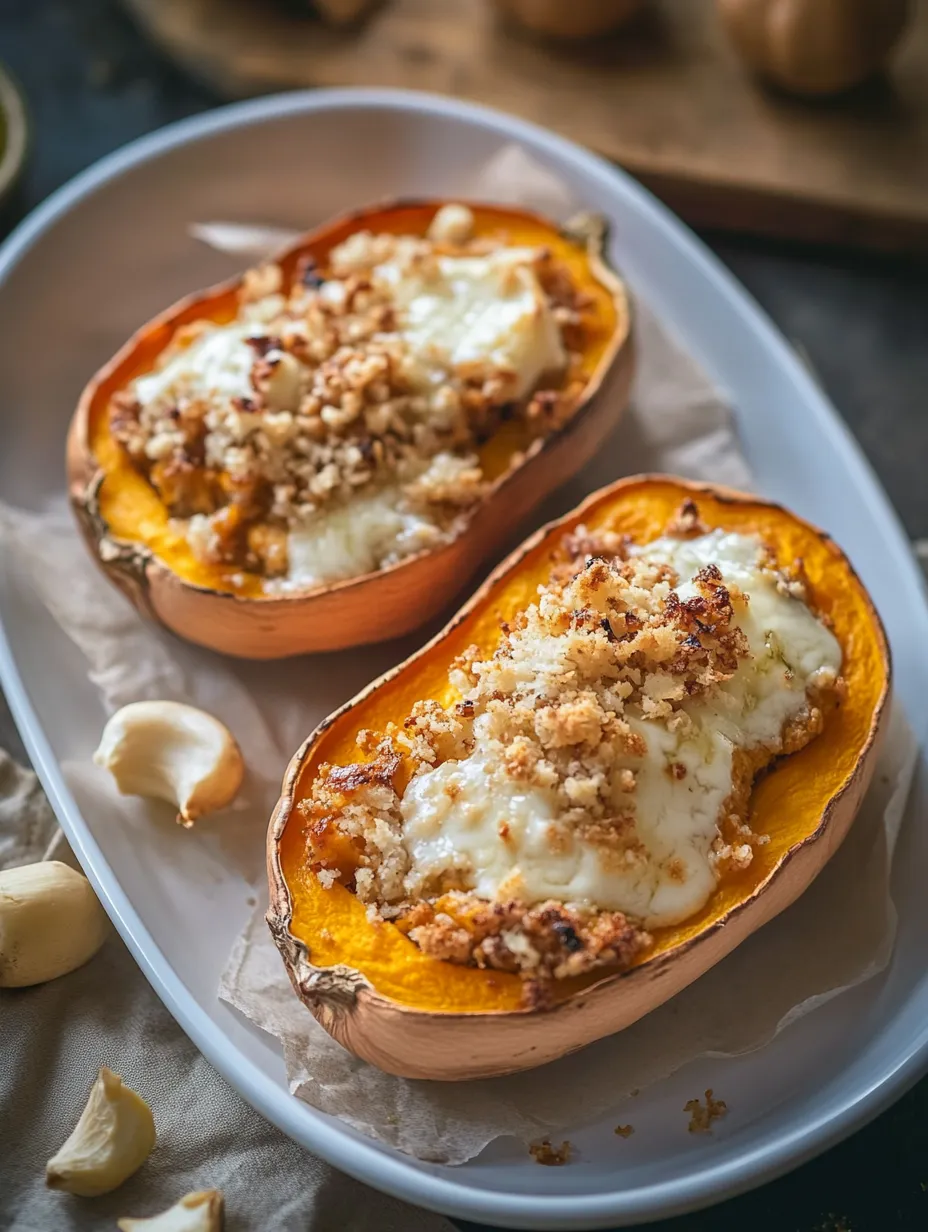 Pin it
Pin it
This cheese-filled butternut squash with bulgur makes a comforting meal that perfectly blends fall flavors. The squash's sweetness pairs wonderfully with the creamy goat cheese and hearty bulgur.
I first tried this at a friend's dinner party last fall. It's now a must-have in my seasonal cooking rotation. Even my kids, who didn't care for squash before, now ask for seconds.
What You'll Need
- 1 medium butternut squash: around 1 kg, look for one that's firm with undamaged skin for maximum freshness
- 80 g bulgur: this grain adds nice texture and protein to your dish
- 1 small onion: creates an essential flavor foundation
- 2 garlic cloves: go for fresh garlic for stronger aroma
- 100 g goat cheese: pick a type you enjoy, either soft or aged based on what you like
- 20 cl heavy cream: use full-fat for a richer result
- Olive oil: a good quality oil will boost the dish's flavors
- Salt and pepper: season to your liking
- Optional add-ins: thyme, rosemary, grated nutmeg, walnuts or pine nuts to make it your own
Simple Steps
- Get your oven ready:
- Heat your oven to 200°C so the squash cooks evenly.
- Prep the squash:
- Give the butternut a good scrub. Cut it in half lengthwise to make two equal parts. Scoop out all the seeds with a spoon. Make shallow cuts in a crisscross pattern on the flesh with a sharp knife tip - this helps it cook better and soaks up more flavor.
- First bake:
- Put the squash halves in an oven-safe dish, cut side up. Brush the flesh with plenty of olive oil. Add salt, pepper, and any herbs you like such as thyme or rosemary. Bake for about 30 minutes. You'll know it's done when a knife slides in easily. If needed, cook for another 10 minutes.
- Work on other ingredients:
- While the squash bakes, cook the bulgur in salted boiling water following package directions, usually 10-15 minutes. In a skillet, cook finely chopped onion and pressed garlic with a bit of olive oil over medium heat for about 10 minutes until the onions turn clear. Put this mix in a large bowl.
- Make the filling:
- Once the squash is cooked, carefully scoop out some of the flesh, leaving about 1 cm against the skin to keep its shape. Add this flesh to the bowl with onions and garlic. Mix in the goat cheese cut into small cubes, add salt, pepper, and any spices you want like nutmeg. Gently stir everything together.
- Final assembly and second bake:
- Spoon the cooked and drained bulgur into the squash cavities. Top with the squash flesh, onion and goat cheese mixture. Pour the cream over everything for extra richness. Return to the oven for about 15 minutes, until the top turns slightly golden and bubbly.
- Ready to eat:
- Serve right out of the oven while hot. Each person can scoop the filled squash away from the skin as they eat.
What I really love about this dish is how versatile butternut squash can be. Its naturally sweet flavor works so well with the tangy goat cheese, creating a perfect balance. On cold winter evenings, my family gathers around this meal which has become our Sunday night tradition during the chilly months.
Storing and Make-Ahead Tips
You can keep leftover stuffed butternut in an airtight container in your fridge for 2-3 days. To warm it up, put it in a 180°C oven for about 20 minutes. To save time, you can prebake the squash a day ahead and prep all other components separately, then put everything together when you're ready to cook. Just know that freezing isn't ideal for this dish as both the squash and cheese might get mushy.
Mix It Up
This recipe bends to whatever you want. Switch bulgur for quinoa, rice, or couscous if that's what you prefer. Not a fan of goat cheese? Try feta, mozzarella or even grated comté instead. For a more fall-inspired version, toss in some sautéed mushrooms or apple chunks. If you enjoy different textures in your food, sprinkle some toasted walnuts or pumpkin seeds on top before serving.
Serving Ideas
This stuffed butternut works great as a main dish alongside a simple green salad with light dressing to balance out the richness. It's also a perfect side for white meats like roast chicken or veal. For fancy dinner parties, add some fried sage leaves or fresh sprouts on top just before bringing it to the table. Plan on half a squash per person for a main course, or a quarter for an appetizer or side dish.
Background and Health Perks
Butternut squash came from North America but has become a staple in French fall cooking. This filling yet low-calorie veggie is loved for its sweet flesh and how many ways you can cook it. It's packed with fiber, vitamins and minerals, making it great for a balanced diet while helping you feel full. Bulgur, a traditional Middle Eastern grain, adds plant protein and fiber, making this dish even more nutritious.
 Pin it
Pin it
Frequently Asked Questions
- → Comment préparer la butternut pour la cuisson ?
Lavez la courge, coupez-la en deux, grattez les graines et entaillez légèrement la chair pour une cuisson homogène.
- → Puis-je remplacer le boulgour par autre chose ?
Bien sûr ! Le quinoa, le riz ou même du couscous peuvent parfaitement convenir.
- → Faut-il cuire la courge avant de la garnir ?
Absolument, précuisez-la environ 30 minutes au four pour qu’elle soit plus tendre à travailler.
- → Peut-on mettre un autre fromage que le chèvre ?
Oui ! Essayez de la feta ou un fromage râpé qui fond bien comme du gruyère ou du parmesan.
- → Comment savoir si la courge est prête ?
Utilisez un couteau : si la lame s’enfonce doucement dans la chair, elle est cuite.
